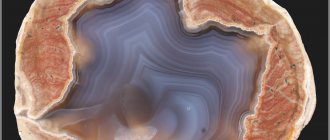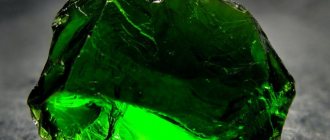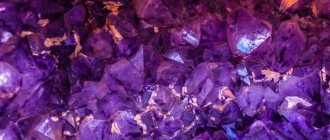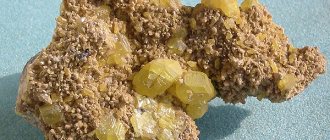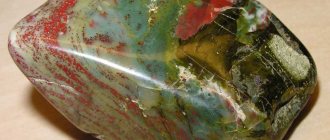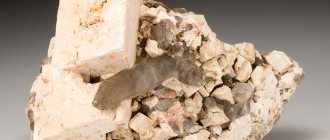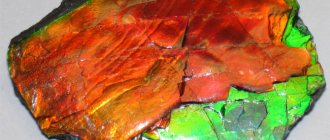Description and external signs
The term “chlorites” refers to a whole group of gems, the deposits of which are scattered throughout almost the entire territory of the globe. What do these stones look like? Their shades are varied. You can find specimens of light yellow color, and sometimes there are dark green, almost black. There are also white stones. The shade of a mineral depends on its variety, of which more than twenty have been identified. The crystals have a pearlescent, oily or glassy luster and a white streak. As for transparency, chlorites can be translucent or clearly translucent in the thinnest plates.
Magic properties
The magic of chlorite has been well studied:
- The mineral cleanses human energy structures (aura, centers, meridians).
- Neutralizes aggression, anxiety, depression, and other negativity.
- Helps you find your life's work.
The effect of chlorite with other minerals is even more effective.
Specimens with quartz, carnelian, and amethyst “swallow” flows of negative energy in a person and the space around him.
Classification
Chlorites are a large family of mica-like minerals with a complex chemical composition, which is why their varieties are determined. These include:
- pennine;
- talc – chlorite;
- corundophilite;
- clinochlor;
- pseudothuringitis;
- delessit;
- chamosite;
- brunswigite;
- thuringite;
- kochubeite – clinochlore;
- Nickel chlorite;
- kemmererite - pennine;
- kukeit;
- pennantite;
- gonerite;
- manandonite;
- grohauite;
- kakleichtenbergite;
- afrosiderite;
- grengesite;
- bavalit;
- nibble;
- chamosite.
Chemical composition and physical properties
If we are talking about pure magnesian chlorites, then their ideal chemical formula can be depicted as follows: Mg3Si4O10(OH)2*Mg3(OH)6. Often magnesium can be replaced by Al, Fe, Ni, Cr, Mn. Although the general chemical formula for Chlorites looks like this: (Mg,Fe,Al,Cr,Ni,Mn)3(Si,Al)4O10(OH)2*(Mg,Fe,Mn)3(OH)6.
If we take into account the structure of Chlorites, these are typical layered silicates, which in many respects are similar to micas. Crystallization occurs in the form of a monoclinic system; they have mica-like cleavage, low specific gravity and relatively low hardness. Thin leaves, which have significant flexibility, but lack elasticity, can be easily split off from crystalline chlorites. This is a feature of their crystal lattice.
From a chemical point of view, chlorites belong to the category of aluminosilicates, the typical impurities of which are aluminum, magnesium, ferrous iron, chromium, and nickel. Such magnesium-enriched ores are called orthochlorites.
| Basic physical properties | |
| singonia | monoclinic, pseudohexagonal |
| Hardness | 2,0 – 3,5 |
| Cleavage | very perfect |
| Density g/cm3 | 2,6 – 3,02 |
| Specific gravity | small |
| Refractive indices | 1.63 |
| IMA class | silicates |
| Selection form | in nature there are aggregates of leafy and radial-radiant appearance, crystalline formations of tabular and prismatic appearance, as well as cryptocrystalline and granular masses |
| Kink | stepped |
| Fragility | Yes |
| Strength | sufficient flexibility |
Chlorite deposits
These minerals predominate in metamorphic rocks, where entire strata of these precious stones are formed. The most famous deposits are the Republic of Crimea, Ukraine, Kazakhstan, Siberia and Transbaikalia, the Urals and the North Caucasus. But there are other regions where this stone is mined. These include Georgia, Uzbekistan, Kyrgyzstan, and Tajikistan.
Switzerland and Italy can boast of deposits, where the Pennine Alps are located, rich in pennine - a mineral classified as Chlorites and having a beautiful appearance.
Forms of being in nature
Radial-radiant aggregate
Orthochlorites are often found in the form of fairly large pseudohexagonal or pseudotrigonal crystals, and leptochlorites are micro- and cryptocrystalline aggregates.
Twins at (110) or (001) are common.
Typically, chlorites form foliated, scaly aggregates and solid masses. Ferrous chlorites are characterized by cryptocrystalline aggregates, oolites and pisolites.
History of the origin of the mineral
The year of discovery of this gem is not known for certain. It is believed that they knew about it in ancient times. The name of natural stone comes from the Greek word “chloros”, which means “green”. This name clearly corresponds to the appearance of the minerals of this group, since most of them have a bottle-green tint. Do not think that the name “chlorites” comes from the chlorine content in these minerals. This is not true at all. Minerologists do not know the chlorine content in these gems, except in the form of microscopic elements.
But there are also unique specimens whose colors are impressive. These are pennines whose colors are pink, carmine red, and violet-red. For the first time such crystalline formations were found in the Urals, and the stone was named after the discoverer A. Kemmerer.
Varieties
Quartz comes in varieties that differ in composition and color:
- Rock crystal, which are colorless crystals or druses that adorn the collections of hobbyists and geological museums;
- Rauchtopaz, also called smoky quartz, has a light gray or light brown color; pleochroism is often observed in it, that is, colors when the viewing angle changes;
- Morion is a black ornamental stone of the first order; when heated to 300C, it acquires a golden color, reminiscent of topaz;
- Citrine - lemon-yellow crystals, this semi-precious stone owes its color to aluminum or lithium ions;
- Sapphire - transparent very rare light blue quartz;
- Amethyst is a precious gem, which is a subspecies of rock crystal with a purple or lilac color;
- Aventurine is a quartz-containing rock that sparkles with golden sparkles due to small particles of mica or hematite; the color of the stone can be from light yellow to red-brown, sometimes green or bluish;
- Prazem is onion-green quartz with particles of actinolite or chlorite, sometimes other green minerals; Rose quartz is a very valuable clear quartz with a pink tint;
- Ametrine or Bolivianite is an extremely rare variety found in Bolivia that has alternating areas of lilac and yellow; Hairworms, also called “hairs of Venus” or “arrows of Cupid”, are rock crystal crystals containing inclusions of rutile or tourmaline, shaped like thin needles;
- Chalcedony is a cryptocrystalline variety of quartz, which has many subspecies with their own names, differing in color and structure features:
- carnelian - yellow, orange or red in color;
- sarder or sard - reddish-brown;
- plasma - green chalcedony;
- chrysoprase - apple-green chalcedony due to an admixture of nickel;
- onyx - chalcedony with alternating light and black stripes;
- carnelian - translucent red or honey-colored chalcedony;
- agate - chalcedony having layers or stripes of different colors;
- Flint - fine-grained aggregates of quartz with chalcedony or opal; very beautiful flints are found in the Moscow region and Poland;
- Cat's eye is a translucent pink or gray quartz with a stripe resembling a cat's pupil;
- The hawk's eye, unlike the cat's eye, has blue veins on a dark blue background;
- The tiger's eye differs from the falcon's eye in its golden-brown color.
- Varieties of quartz include opal - amorphous quartz, which has a beautiful play of colors due to the tiny droplets of water it contains;
- Jasper is also one of the varieties of quartz, which contains a large number of impurities, causing a very rich range of colors; Heliotrope is a variety of jasper with bright red dots on a dark green background.
Scope and scope
Some varieties of this mineral are used industrially as iron ore. But this gem has found itself in other industries. Thus, it was often used as a dye. It is in great demand among jewelers, especially pieces with unique shades. But in jewelry, clinochlore is mainly used. Beautiful products and jewelry are made from it. A variety of Chlorites – thuringinite – is of great value. You can use it to make unique crafts for your office. It can also be a decoration for any mineral collection.
Zodiac sign
This stone is classified as positive, so wearing it cannot harm anyone, and there are no signs of the Zodiac for whom it is not suitable. But still, the effect of Chlorite on different people varies significantly.
- Aries who dream of a career should purchase a ring with this stone. He will instill confidence in them, strengthen their speaking abilities, help them stand out from the crowd and prove that this particular person is worthy of leading a business direction or being the manager of a major project.
- If Taurus is tired of annoying acquaintances and wants to be with their family, it is enough to have a Chlorite amulet in the house. He will not only ward off boring and annoying regulars who do not know the limits in communication, but will also protect the family hearth from the encroachments of ill-wishers and envious people.
- For Gemini, Chlorite will be an assistant in establishing love relationships. He will support you in difficult times, give you courage, perseverance, and make you believe in your attractiveness, devotion and fidelity.
- For Cancers, this stone will be neutral.
- Leos can safely rely on Chlorite if they decide to go into business. It will help you find reliable partners, conclude profitable contracts, protect you from significant losses and thoughtless investments, and prevent careless businessmen from constantly extracting money from you for their needs under a good pretext.
- If Virgos lack confidence and determination, buy a Chlorite talisman for yourself. It will multiply all your positive qualities, make you persistent, non-criminal, capable of convincing people that you are right and not allowing you to be won over to your side.
- To maintain love and mutual understanding in the family, Libra is recommended to constantly wear jewelry made from Chlorites. This will help spouses find a common language on all issues, be tolerant, restrained, give in, not quarrel over trifles, maintain mutual understanding and respect.
- Suitable for Chlorite and Scorpios. This is especially true for creative individuals, as well as people whose profession is closely related to constant communication. We are talking about teachers, doctors, educators, political and public figures, and philanthropists.
- Sagittarius can safely rely on this stone when making work-related decisions. He will help you choose the most optimal path to achieve the desired result, he will tell you who you can rely on, and who it is better to keep at a respectful distance so as not to fail the case.
- Excessive stubbornness and arrogance of Capricorns can negatively affect the process of communicating with people. In order to avoid conflict situations, you should keep such a pebble with you and regularly squeeze it in your hand. It will calm you down, cool down your ardor, remove excessive excitability and force you to think soberly, thereby avoiding troubles.
- For Aquarius, the presence or absence of Chlorite does not fundamentally change anything in life. But after a hard day at work or serious meetings, you want to relax and the gem will help with this. You just need to hold it for a few minutes and you will feel warmth, comfort, peace and tranquility.
- If Pisces wants to impress members of the opposite sex, wear jewelry with Chlorite and you will be noticed, highlighted and appreciated. You don’t even have to make an effort, everything will happen by itself.
Healing properties of the stone
No one doubts that Chlorite is endowed with unique healing qualities. Legends and beliefs speak about this. It is also worth considering that green is a symbol of calm and tranquility. It is known for certain that this gem has a positive effect on the body’s readings, improves blood circulation, normalizes weight, stabilizes blood pressure, and cleanses the body of toxic substances. It also promotes the absorption of vitamins and beneficial microelements and monitors the condition of the intestinal microflora.
The aura of the stone is so strong that it can relieve pain in the back, knee joints, help with headaches, cure all sorts of diseases, and protect against chronic diseases. It can also easily cope with allergic reactions. This stone is recommended to be worn by people prone to stress, melancholy and apathy. Moreover, it does not matter what shape it is cut into, what kind of setting exists for the stone, and what finger it is worn on. The main thing is that a person believes in his healing abilities and trusts him. It is perfectly compatible with any stone.
Magic properties
The cleansing properties of Chlorite are of great importance, so it should be worn when there is a feeling that you are overcome by negative energy, stressful situations do not allow you to concentrate and confuse you, activity decreases and apathy appears. To avoid the influx of negative energy, free yourself from negative emotions, cope with fear and aggression towards loved ones and others, use the power of this stone. The method of finishing and cutting does not have any effect on the magical abilities of the gem.
Chlorite is also able to remove the evil eye and damage from people, even prevent their induction. But the positive energy of the mineral has a positive effect not only on humans, but also on the environment. Therefore, it is good to have such a talisman at home and no adversity or problems will visit it.
Decorations
Chlorite is used to create a variety of jewelry. These can be rings, rings, bracelets, earrings, pendants, cufflinks. Most often, jewelers pay attention to purple, pink, black and yellow stones. The cost of the products is reasonable, and the appearance is excellent. Such crafts are preferred by true connoisseurs of natural beauty.
It is best to wear this gemstone to match your eye color and decorate your outfits with it. This mineral can often be found at fashion shows of famous brands.
Which is better for a bath: rolled soapstone or crushed soapstone?
Soapstone (photo): crushed and diked
For many stones, tumbling is mainly a matter of aesthetics, but this is not the case with soapstone. The fact is that this stone generates more dust, the more uneven its surface is . This is why polished samples are less prone to destruction than fragmented ones.
Galvanized or bunded (which is the same thing, but the former is more correct) stone is an intermediate degree of processing between a fragment and a polished sample. It would be strange to put the latter in the heater, so it is better to take bunded soapstone.
How to distinguish from a fake
If you are not a specialist in the field of mineralogy, then it is almost impossible to independently determine the original Chlorite. Currently, both natural and synthetic representatives are subjected to special heat treatment. This makes it possible to remove cracks and make the shade more saturated and attractive. You can also find natural and fake elements glued together.
The proposal to purchase a rare stone at an affordable price at a retail outlet should raise great doubts. You should not covet such a product. It is quite difficult to recognize the original and the imitation. Specialists must work here using appropriate equipment and instruments.
Features of using soapstone tiles
Before heating a stove lined with soapstone, it is necessary to rinse the finishing surface thoroughly with water using a stiff brush. Then heat the oven well. You can water the stone cladding without fear that it will crack. At the same time, the soapstone will absorb part of the water and will gradually release light, uniform steam into the bathhouse.
Experts recommend using horizontal lining of the internal surfaces of the furnace, and vertical lining of the external planes. Thus, the furnace quickly heats up and cools down slowly.
Stone care
The softness and excessive fragility of Chlorite cannot be discounted, so its care must be given due attention, as well as handling it carefully. If you purchased products with this mineral, they must be stored separately from other jewelry, not subjected to mechanical stress, and protected from falling. For this purpose, individual cases with soft upholstery are used. To clean the gem from dust, you need to use a soft cloth and cool running water. Drying in direct sunlight is not recommended. The use of cleaning agents is strictly prohibited.
Compatibility with zodiac signs
The stone suits all zodiac signs. There are peculiarities, but, in extreme cases, it acts neutrally. It is advisable to choose a color depending on the specific zodiac constellation:
- Aries is better off taking white quartz . The sign is active, persistent, but lacks insight and constancy. The mineral will help fix this.
- A green gem will suit calm, confident Taurus. It will lift your spirits and give you flexibility.
- It is advisable for Gemini to choose yellow or red . These people often come into contact with others, so they would benefit from protection from the evil eye.
- Amethyst is suitable for Cancers. The mineral will soften uncertainty and psychological stress. There is no need to combine it with other gems.
- Pink is favorable for Leos. The stone helps them express themselves more fully and implement creative plans.
- Virgos need to pay attention to sugar . This variety protects from unnecessary thoughts, especially unpleasant ones.
- Cactus quartz is recommended for Libra . Harmony and love are especially important for these people. The stone will suggest the right solutions in conflict situations.
- For Scorpios, hairy beans are suitable, preferably with an admixture of rutile . It complements natural insight. It becomes easier for Scorpios to implement ideas.
- Sagittarians are advised to wear red and pink . The stone protects against rash actions and makes representatives of the sign more diplomatic.
- Capricorns need smoky quartz. It helps overcome isolation. In communication, Capricorns gain additional strength and become more cheerful.
- It is advisable for extraordinary Aquarius to take golden . The stone develops talents and helps bring “inventions” to other people.
- Blue will suit dreamy Pisces. The gem protects from unnecessary mental trauma and helps to develop spiritually.
Some types of stone patronize several signs. For example, green, in addition to Taurus, can be worn by Libra and Aquarius. White quartz (crystal) is also suitable for Leos, Pisces and Scorpios.
